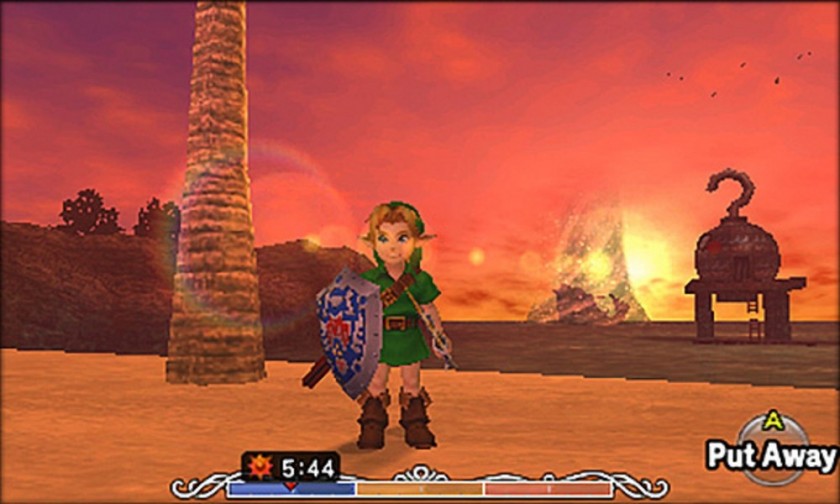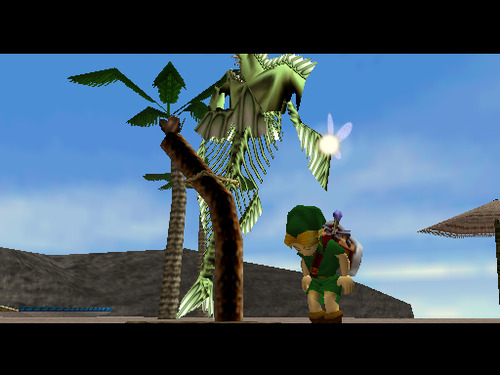
The Legend of Zelda: Majora’s Mask 3D on Nintendo 3DS is a 2015 remaster of the original Majora’s Mask game which came out on the Nintendo 64 in 2000. It’s an Action/Adventure video game where the protagonist, Link, a young hero from the fantastical world of Hyrule, must fight Skull Kid, the antagonist. Link has to prevent him from bringing down the Moon on the strange world of Termina and destroy it. In this analysis, I will explore how the aesthetics and mechanisms of the game combine to convey a consistent theme of urgency such as to create a unique play experience.

The protagonist, Link

Different commands can be assigned on the touch screen of the 3DS to be used in fights, dungeon exploration, etc.

Link transforms to be able to navigate underwater
Solving a puzzle sound effect
To defeat Skull Kid, Link has to get the help of four giants. They are awakened and rallied to Link’s cause by clearing their respective dungeons. The player explores the 3D world of Termina moving around with the joystick, and fights all sorts of enemies – giant spiders, creatures made of darkness, carnivorous flowers, anthropomorphic jelly, etc. Link uses a variety of weapons including bombs, arrows, and a blade using buttons X, Y and B and the touchscreen. In addition, Link can find different magical masks, which are used to transform into different creatures – a merman who breathes underwater, a golem who destroys path-blocking boulders, etc – which unlocks previously unexplorable areas, and gives the player new playstyle options as each transformation fights and moves differently. Finally, Link can also learn songs to play on his ocarina, using the buttons of the 3DS as notes. Playing the songs changes the environment around Link, calls his horse, calls giants, etc. All of these elements – the masks, the songs and other items – need to be used creatively in the dungeons to navigate and fight the dungeon boss. The process requires a lot of wits from the player, but the victorious sound effect that comes with solving a puzzle always fills the player with the satisfaction of having made well-deserved progress – a proof of good game design, where the challenges are not so bad that they are unsolvable, and provide immediate feedback for the player’s success.

The moon can always be seen in the sky, and gets closer every in-game day

The game’s environment seems to come out of a child’s fever-induced nightmare
Link seems to be in pain as he transforms using a mask
But besides the masks and songs, there is one mechanic that sets this game apart from any other Adventure/Action game (or any game for that matter); if you play for more than 3 days in-game time (where one hour amounts to one real-life minute), Skull Kid succeeds in bringing down the moon, the world ends, and you lose. But 72 minutes of playing is not enough to defeat him, it is not even enough to clear the first dungeon! There is though one way to prevent that; playing the Song of Time on Link’s ocarina, and going back to the start of the first day. Doing this gives the player more time, but also resets most of the progress made so far, including losing all money and items – excluding a few key ones such as masks – hoarded. This gives a strong sense of urgency to the play experience; the player must at all times think of how best to spend their precious time and maximize their efforts so that they do not go to waste at the end of the cycle. They have to learn X song before the 3 days end so that they can use it to unlock a dungeon Y at day 1, which they must finish at the end of day 3, so that they can directly confront the dungeon boss at day 1, etc. This urgent feeling is reinforced by various aesthetic elements of the game; first there is the creepy human-faced moon that is always looming, and gets a little closer and bigger every hour. Then there is the music that gets faster and darker as there is less time left. The environments and models, with their purple hues and edgy designs, have a masquerade and dreamlike (or rather nightmare-like) quality to them which adds to the apocalyptic tone. The game verges on horror whenever Link transforms by putting on a mask, which distorts in a grimace and screams horrifyingly. There is also a sense of tragedy to the game, as the player gets to learn the routine of the denizens of Termina, how they gradually come to accept the imminent apocalypse through the days and make preparations for it in an endless cycle. In one portion of the game, the player works to bring Spring back to a village trapped in perpetual winter. The saved inhabitants are thankful to Link and applaud his efforts. It is therefore particularly crushing to let them down as the winter will still be there at the next cycle, and that the inhabitants will not even remember Link’s involvement.

Link builds a grave for a dead musician. The grave remains in its place despite the subsequent resets
Yet, there is comfort, too, in the game. Some changes that Link makes to Termina do matter, and they survive the reset of the timeline. For example, Link meets at some point a dying musician. Link lays the man’s soul to rest by playing a special song, and, at his request, he buries him with his guitar and a special epitaph. The moment is touching, and leaves a mark on the player as the grave will remain there 3 days earlier, a somewhat morbid yet hopeful sign that Link’s efforts are not after all in vain. The game is also full of sidequests where the player has to interact with villagers at specific times of the day to solve their problems. For example, one quest involves reuniting two lovers who want to get married before the impending apocalypse. While these stories are undone with each new cycles, they nevertheless leave an impact, particularly when the rewards are masks, which act almost as souvenirs, reminders of what matters. The game creates meaning in the masks and further motivates the player to save the world, as they get to know the people of Termina and grow attached to them, even if they might not remember them. Majora’s Mask is a game about inevitability and despair, but also about hope and triumph over impossible odds.